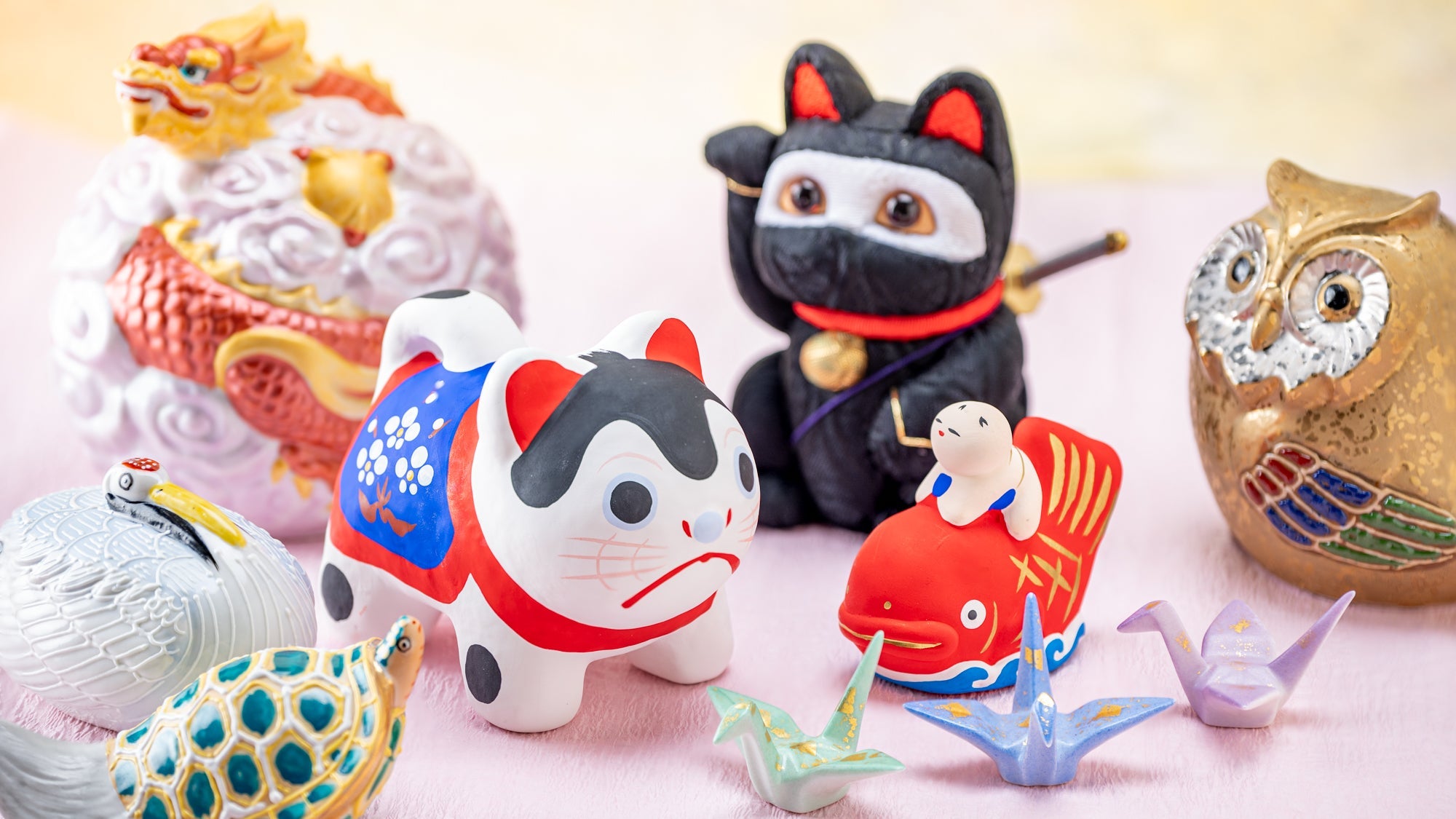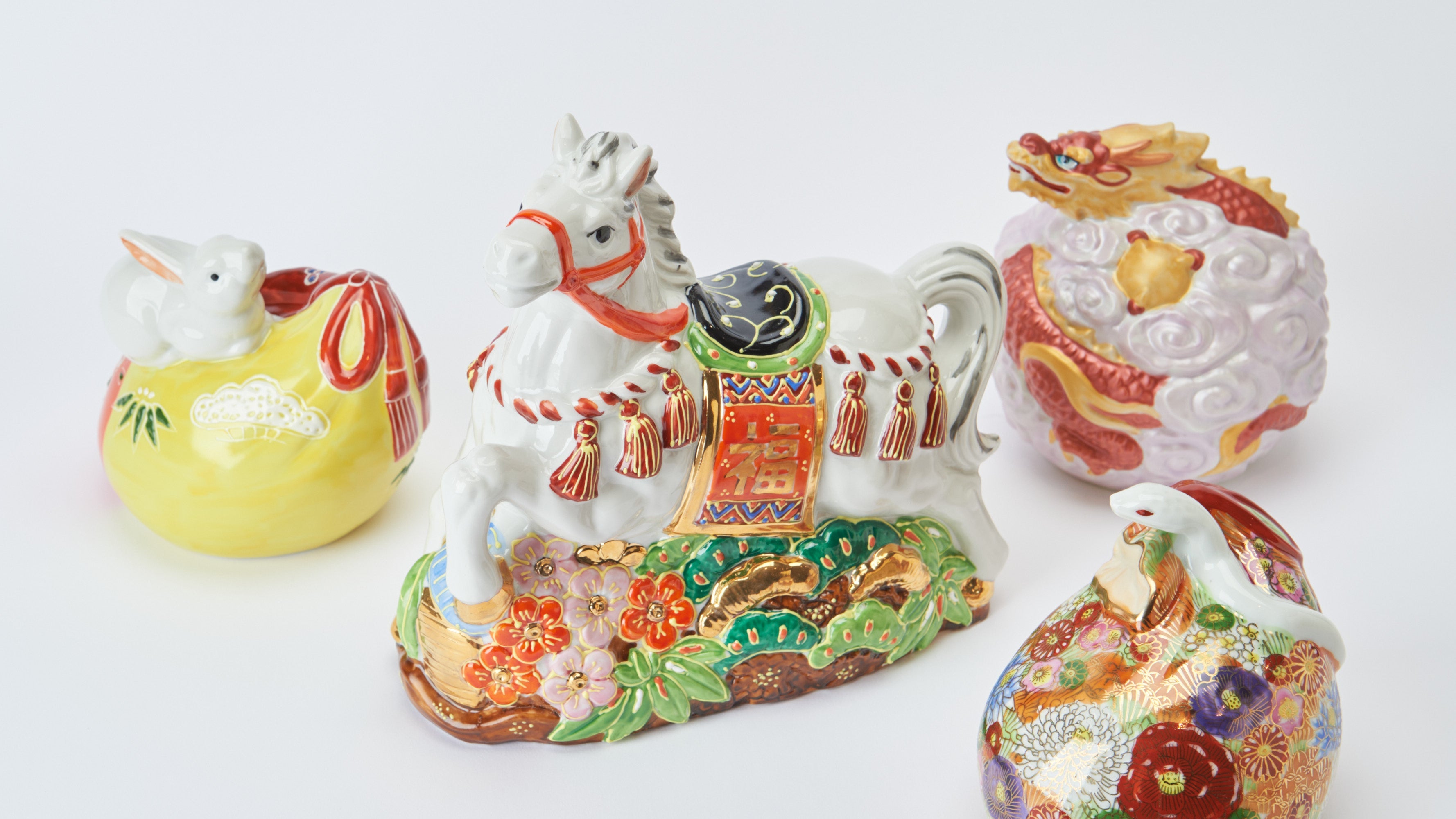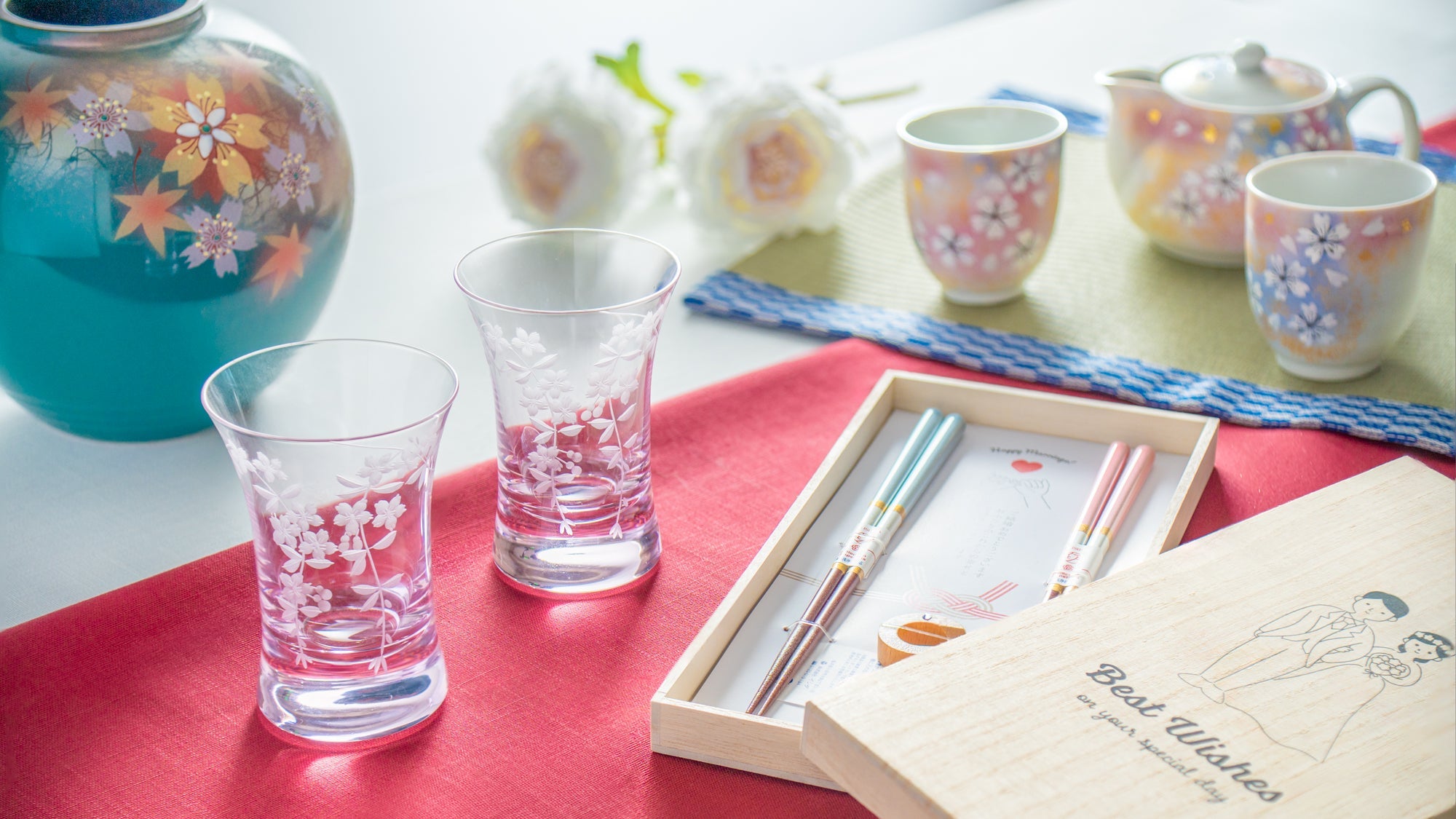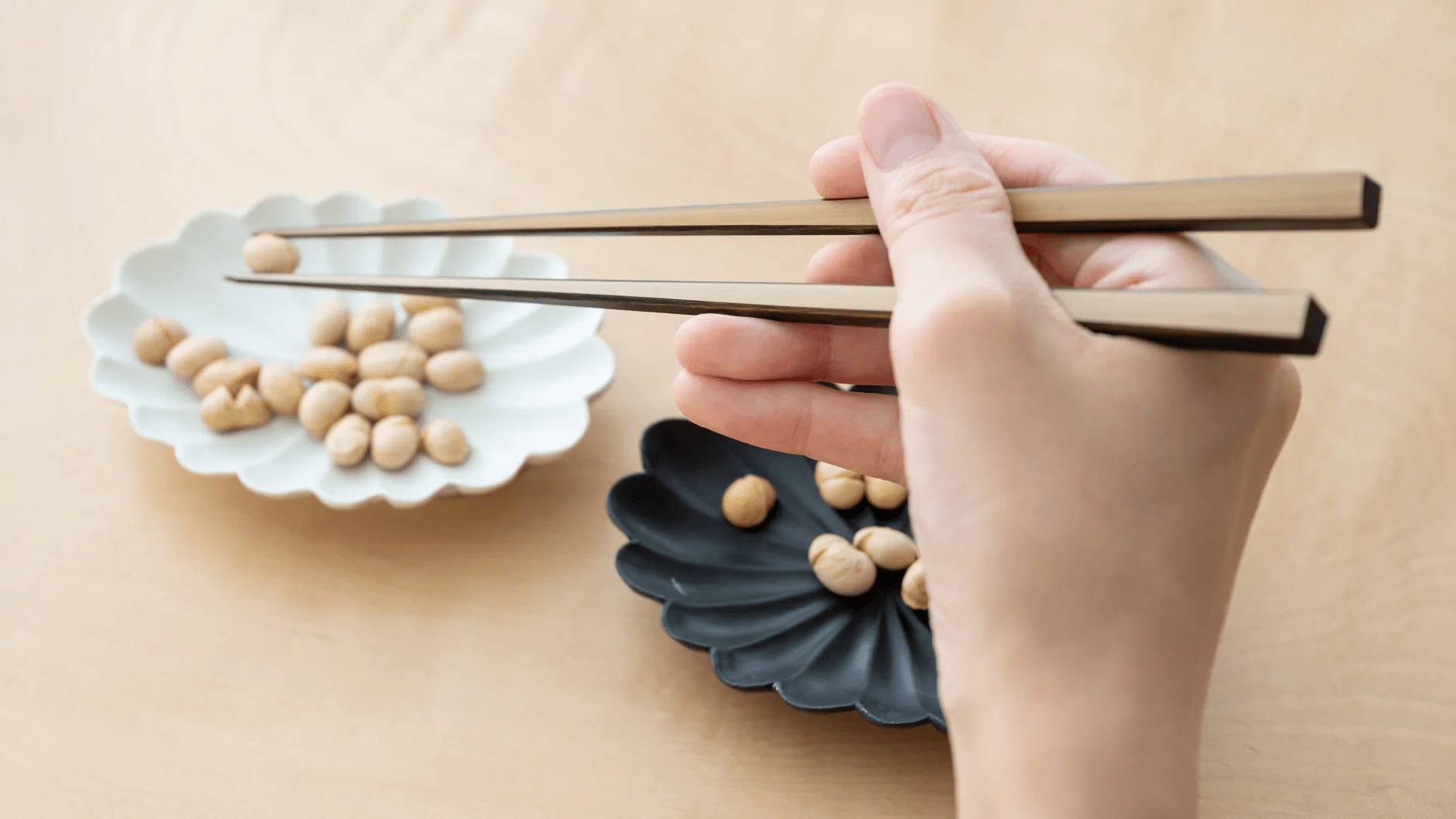
Farming Good Fortune with Auspicious Animals
Written by Team MUSUBI
When it comes to luck, there are a lot of omens and charms available in Japanese culture. You may have noticed a common theme: animals. Us humans enjoy animals in their many forms, including as companions, witnessing them in nature, or teaching little kids the noises they make. But they have another significant role—bringing good fortune to our lives.
Let's explore the legends behind the animals and their auspicious figurines. We'll also have some suggestions for gifts based on the meaning.
tables of contents
Dogs / Inu

Dogs have always had a protective presence in Japanese culture, and one of the most revered forms is the komainu. These guardian lion-dogs often appear in pairs at the entrance of shrines, standing as silent sentinels to ward off misfortune and keep negative energies at bay. The pairing is symbolic—one komainu has its mouth open (representing the sound "a"), while the other’s mouth is closed (representing "un"), together forming the sounds of the beginning and end, a reminder of completeness and protection.
Historically, ceramic versions known as Seto Komainu were also crafted as symbols of protection, particularly for homes. Whether placed at the entrance or as part of an interior space, this stoneware komainu figurine channels the same protective energy, inviting a sense of safety and warding off misfortune. A perfect gift for someone starting a new chapter, or for safeguarding your own personal space with a touch of tradition.
Sea Bream / Tai
The sea bream, known as tai, holds an auspicious place in Japanese culture. This beloved Japanese fish plays on the word medetai, meaning "congratulatory" or "auspicious," making it a symbol of good fortune. Sea bream often takes center stage at important milestones—such as during okuizome, a traditional ceremony held 100 days after a child’s birth, where a whole sea bream is served to wish for the child’s lifelong health and prosperity.
A delightful take on this symbolism is the tai-nori-doji—a figurine of a child riding atop a sea bream. The cheerful imagery expresses a wish for children to grow up strong and healthy. This playful stoneware piece radiates charm and meaning, offering both joy and blessings to any space.
Dragons / Ryu
A symbol of strength and power, the Japanese dragon is unique in that it does not have wings, contrary to the Western image. They are one of the guardians of Buddhism, so you'll frequently see them in statues and paintings around temples. Additionally, they are often pictured in water because they reign over the oceans and fight to defend the gods.
There is a special celebration of the dragons at Senso-ji, a famous Buddhist temple in Tokyo. This ceremony, called Kinryu no Mai or Golden Dragon Dance, takes place in the spring, and at the center of the festivities is a massive, 18-meter-long (about 59 feet) golden dragon, carried by 8 dancers. The dance is meant to pay tribute to Kannon, the deity to which Senso-ji is dedicated, who took the shape of a golden dragon and created 1,000 pines overnight.
Much like the commanding presence of 1,000 pine trees, a dragon motif in your home, such as the Choho Kiln Kutani Kinsai Jewel Dragon, adds strength and protection. And this is their year—so perhaps any dragons you bring home will receive an extra boost of power.
Carp / Koi
When you picture a peaceful body of water in Japan, what do you see? Waves shimmering in the sunshine, and a glimmer of orange-red peeking out from the depths? You're envisioning the striking koi fish, a ubiquitous figure in aquariums, lakes, and ponds throughout Japan. Koi are a familiar freshwater face, their sturdy shape and long life have made them symbolic of longevity, good health, and good fortune.
In May, there is a holiday called Children's Day meant to wish for the health and prosperity of kids. To celebrate, koinobori, or koi-shaped windsocks, are hung outside on a pole. This tradition invokes the image of koi swimming up a waterfall, based on a legend that says koi are so strong they can overcome many challenges and swim up a waterfall. So a koi-decorated item, like the Yoshita Kasho Koi Fish Maki-e Glass Sake Cup, is the perfect way to send strength and support to a loved one.
Cats / Neko
The legend goes that a feudal lord saw a cat waving at him with its paw as he stood under a tree. Now, cats are considered protective spirits, symbolizing good fortune. There are even a few islands throughout Japan that can be called "cat islands," including Aoshima. Located in Ehime prefecture, Aoshima has around 15 residents to over 100 cats, so the land is definitely theirs.
Cats are often seen as patterns on home goods or, more famously, as the maneki neko figurine. Maneki neko translates to "waving cat" and is placed at the front of businesses because they are believed to welcome success. Placing one in your home can have a similar effect. Maneki neko are so beloved, they are frequently decorated in different outfits, colors, and themes to make them even more unique. Take for example, this Kakinuma Ningyo Black Ninjya Edo Kimekomi Doll Lucky Cat, decked out like a ninja.
Cranes / Tsuru
Considered a national treasure in Japan, the majestic crane is known as "the bird of happiness." This comes from the idea that when a crane finds its mate, they stay together for a long time, and not only that, cranes are said to live for up to 1,000 years. This long lifespan is attributed to good health, so they are symbols of longevity, good health, and love.
Their magnificent image is often painted onto other lucky items like a kozuchi, or lucky mallet. A standalone crane figurine can bring luck, and it is also sometimes paired with a turtle, due to a famous Japanese folklore about the two long-living animals helping each other out through hard times. Giving a crane to someone not only represents your lasting love for them, it is a wish of good health and good fortune for a long life, so why not decorate their meals with this Origami Crane Kutani Chopstick Rest Set?
Turtles / Kame
Turtles, with their noble aura, have a long history of appreciation within Japanese history. Walking through the national parks and gardens, you may see turtles having a swim in the water or sunbathing on the shores. Turtles may also be found near the water elements in a shrine's garden—these turtles are considered sacred.
Turtle mythology depicts them as powerful and immortal, and one of the most notable representations of this is the minogame. Minogame is a turtle that has lived for thousands and thousands of years, growing a long, flowing tail of algae as it ages. (This algae tail is something that happens to old turtles in real life, too!) The turtle is often paired with a crane to emphasize the wishes of a long life, so presenting someone with this Kutani Crane and Turtle Figurine Pair will tell them, "I love you and want you to stick around for a long time."
Rabbits / Usagi
You may be familiar with the idea of a lucky rabbit's foot. It's not too far off from their place in Japanese folklore, though these stories keep them whole. In fact, it's the combination of their long ears and hopping gait that make rabbits symbolic of longevity and progress.
Rabbits have been admired for many centuries and represented across many mediums, from kimono fabric to paintings—and rabbits even feature in what is considered the world's oldest manga, called Choju-giga. Present the Tosen Kiln Kozan-ji Temple Choju Giga Kiyomizu Ware Matcha Bowl Chawan to someone who has achieved something great or needs a boost of confidence, the lively, bouncing bunny's image will remind them to always keep looking forward.
Owl / Fukurou

Owls are considered fortunate animals due to the play on words in Japanese: "Fukurou" can be interpreted as fuku kitarou, meaning "luck comes," or fukurou, meaning "without hardship." As a result, owl-themed items are often collected as charms for bringing good fortune and ease in life.
This Choho Kiln Gold Kutani Owl Figurine is a luminous golden owl figurine, expertly crafted from Kutani ware porcelain. This small, round owl, with a serene golden hue enhancing its plumage, exudes a charm that blends endearment with sophistication.
You'll note this isn't an exhaustive list of animals that have importance in Japanese culture. There are many more, including dogs, frogs, monkeys, snakes, and so much more. But it's a good place to start creating your own collection of lucky animals or seek inspiration for a gift to a special someone who could use a little extra luck sent their way.














Leave a comment
This site is protected by hCaptcha and the hCaptcha Privacy Policy and Terms of Service apply.